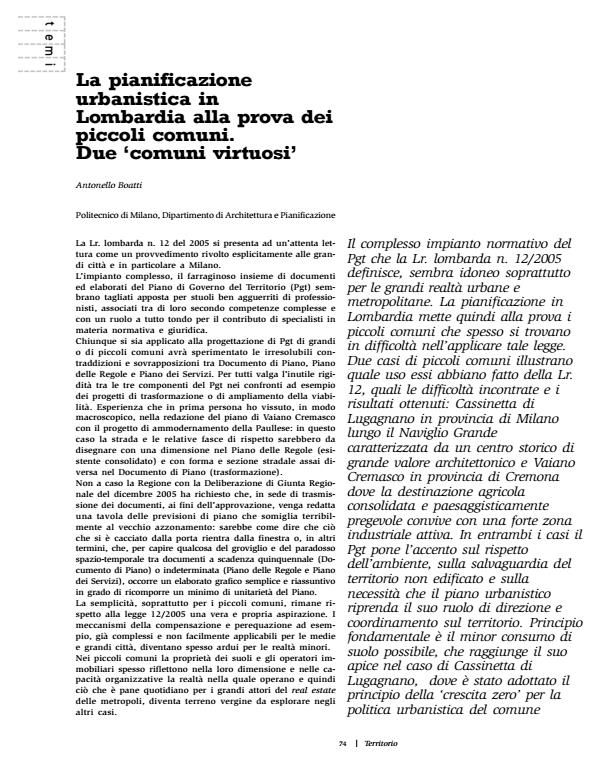La pianificazione urbanistica in Lombardia alla prova dei piccoli comuni. Due "comuni virtuosi"
Journal title TERRITORIO
Author/s Antonello Boatti
Publishing Year 2009 Issue 2009/49
Language Italian Pages 7 P. 74-80 File size 615 KB
DOI 10.3280/TR2009-049010
DOI is like a bar code for intellectual property: to have more infomation
click here
Below, you can see the article first page
If you want to buy this article in PDF format, you can do it, following the instructions to buy download credits

FrancoAngeli is member of Publishers International Linking Association, Inc (PILA), a not-for-profit association which run the CrossRef service enabling links to and from online scholarly content.
Urban planning in Lombardy, put to the test by small municipalities. Two "virtuous municipalities" - The complex regulations for general plans which the Lombard Regional Law No. 12/2005 defines, seem suited above all to large urban and metropolitan realities. Planning in Lombardy therefore puts small municipalities, who often find difficulty in applying that law, to the test. Two cases of small municipalities illustrate the use they have made of Regional Law n. 12, the difficulties they encountered and the results achieved: Cassinetta di Lugagnano in the Province of Milan along the Naviglio Grande canal, with a town centre of great historical architectural value and Vaiano Cremasco in the Province of Cremona, where the consolidated agricultural land use and an attractive landscape sit alongside an active and heavily industrialised district. In both cases the general plan places the accent on respect for the environment, on safeguarding unbuilt land and on the need for urban planning to take back its role in directing and co-ordinating the environment. The main fundamental principle is that of the least consumption of land possible which is taken to the utmost in the case of Cassinetta di Lugagnano, where a principle of ‘zero growth’ has been adopted for the municipality’s urban planning policies.
- Towards Sustainable Urbanization. Learning from What’s Out There Alys Solly, Erblin Berisha, Giancarlo Cotella, in Land /2021 pp.356
DOI: 10.3390/land10040356 - How Sustainable Are Land Use Tools? A Europe-Wide Typological Investigation Alys Solly, Erblin Berisha, Giancarlo Cotella, Umberto Janin Rivolin, in Sustainability /2020 pp.1257
DOI: 10.3390/su12031257
Antonello Boatti, La pianificazione urbanistica in Lombardia alla prova dei piccoli comuni. Due "comuni virtuosi" in "TERRITORIO" 49/2009, pp 74-80, DOI: 10.3280/TR2009-049010